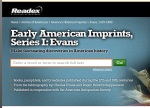What follows is a rudimentary guide to how to access the Early American Imprints database, with a brief background on what it is and the steps to take to find individual documents.
The Early American Imprints database is one of the key online collections for research in early American printed materials. It grew from two sources. First was the bibliography compiled by Charles Evans, titled American Bibliography, first published between 1903 and 1934. Evans tracked the publication of every known imprint in America from 1639 to 1800. American Bibliography eventually encompassed fourteen volumes covering over 30,000 imprints from the time period. Evans assigned each a unique identifying number, which system was continued in Early American Imprints.
After his death, the American Antiquarian Society collaborated with the Readex Corporation to make its extensive collection of early American imprints available to the public on microform, using Evans’s American Bibliography as a guide. In the 1990s, AAS and Readex worked to digitize the collection into what is now Early American Imprints, Series I, which includes not only the items in Evans’s bibliography (at least those that are extant) but also numerous additions and corrections.
To access the database, students at Framingham State University should acquire a Boston Public Library e-card, which are available for free to all Massachusetts residents and anyone attending a school in the state. Once you’ve done that, you can follow the steps below to access and search the database.
- Go to the Boston Public Library’s list of e-resources, scroll down to or search for “Early American Imprints,” and click on the link.

- Enter your e-card number and PIN as instructed. This should take you directly to the interface for the database.

- From the initial page, you can conduct a simple search with a string of words or phrases. The database is full-text searchable, which means that you can look for any word appearing in any of the over 30,000 texts on the site, in addition to looking for specific titles, publishers, or dates of publication. If you scroll further down, you can also browse for documents by selecting a variety of categories.

- You can also select “Advanced Search,” which will allow you to specify the field in which to search.

- For students in any of my courses, you should have listed on the syllabus the full citation for any documents we will read, so you can search by title, Evans number (the unique identification number at the end of the citation), author, etc. to find the source.
- Once you come to a source, it will take you to a page viewer that will show you the first page. You can use the left-hand menu to navigate the document, or above the document select the option “Download pages” to create a PDF that you read on your computer or print out.
My students: if you have any additional questions, please let me know. And if anyone has additional tips on how to use the database, please feel free to add those in the comments.